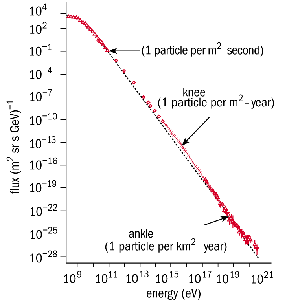
NASA’s Goddard Space Flight Center is coordinating a study, by an international collaboration, of a high-energy cosmic-ray instrument for the International Space Station. The Advanced Cosmic-Ray Composition Experiment for the Space Station will study cosmic-ray nuclei at around 1015 eV in energy to understand better the mechanisms by which particles in the galaxy are accelerated to such high energies.
The Advanced Cosmic-Ray Composition Experiment for the Space Station (ACCESS) will complement terrestrial cosmic-ray air-shower arrays and balloon-borne experiments. It will have the advantage, however, of being able to intercept the incident cosmic rays in space directly rather than observing the showers that they produce when they interact with the atmosphere. This will allow ACCESS to determine the chemical composition of the high-energy cosmic rays directly and should lead to a better understanding of how particles are accelerated in the galaxy. A flight is planned for 2006.
The cosmic-ray energy distribution shows a remarkably uniform slope over many orders of magnitude. There are, however, two kinks in the distribution. One the “knee” occurs near 1015 eV. The second the “ankle” is below 1019 eV. Near both energies, cosmic rays have attracted considerable interest. Above about 5 x 1019 eV, cosmic rays should not exist. If they originate from a distant source, then their energy should have degraded through interaction with the cosmic-microwave background radiation. If they originate nearby, then it would be surprising if we had not already detected the accelerating source. Thus their origin remains a mystery.

Studying such events is hampered by the extremely low frequency of the cosmic rays; above 1020 eV around 1/km2 per century is detected. However, at the knee, where ACCESS will concentrate its efforts, the rate is about a billion times as high and theories exist for an acceleration mechanism. The most popular theory involves shock waves from supernovae. These will accelerate not only particles blown out in the supernova explosion but also any particles that they encounter as they spread throughout space.
Shock-wave acceleration can account for the cosmic-ray spectrum out to about 1014 eV but has difficulty in going much further. Two possible explanations have been suggested to explain the observation of cosmic rays at higher energies, and ACCESS will be able to distinguish between them. The first assumes that the supernova shock-wave model is essentially correct. This would accelerate protons to 1014 eV and heavier elements up to higher energies. Iron, for example, would reach 3 x 1015 eV. Another, unknown, mechanism must then be invoked to explain the spectrum at higher energies, with the kink in the distribution being due to overlap between the two mechanisms and the progressive change in chemical composition as the knee is approached. Candidates for the mechanism include rotating compact magnetic objects, such as neutron stars, or black holes.
The second potential explanation postulates a smooth energy distribution up to the highest cosmic-ray energies with some, as yet unknown, loss mechanism beginning to take effect at about 1015 eV and giving rise to the observed kink. By measuring the chemical composition of the cosmic rays at 1015 eV, ACCESS will be able to put the first explanation to the test.
ACCESS is an experiment at the overlap between terrestrial particle physics and astrophysics. The particle detector technologies originate in particle physics experiments but are being pushed to their limits by the volume and weight constraints of a space-borne experiment. The ACCESS team recently tested potential designs for its calorimeter and Transition Radiation Detector in test beams at CERN. The final ACCESS detectors will be calibrated in CERN beams before launching the instrument into space, where it will measure cosmic rays at energies more than 1000 times as great as current accelerators can deliver.








